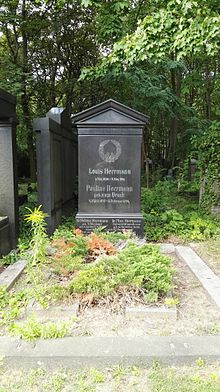Helene Herrmann

Helene Ulrike Herrmann , née Schlesinger (born April 9, 1877 in Berlin ; † July 10, 1944 in Auschwitz ), was a German teacher and literary scholar.
Life
Hermann was the daughter of the businessman Emil Schlesinger and Martha geb. Avellis. She was born in her parents' apartment at Mohrenstrasse 37. From 1893 to 1897 she attended Helene Lange's “Gymnasium courses for women”. In 1898 she married the theater scholar Max Herrmann ; at the same time she began studying German philology and art history at Berlin University. As the first married woman in the German Reich, she received her doctorate in 1902 under Erich Schmidt and Wilhelm Dilthey with the thesis "The psychological views of young Goethe and his time".
In 1907 she passed the examination for teaching at secondary schools and took up a position as a teacher at the Falkschen Gymnasium in Berlin. She also taught in the humanistic courses of Sigmund Auerbach, after whose death she took over the school management. In 1933, together with Vera Lachmann , she founded a small private school in Berlin-Grunewald , mainly attended by Jewish children , at which Helene Herrmann taught English, French and Latin; her husband Max Herrmann had already been dismissed from his academic positions because of his Jewish origins. In 1938 the school was ordered to be closed; from this time on, Helene Herrmann only gave private lessons.
On September 10, 1942, Helene and Max Herrmann were deported on the 63rd transport from Berlin to Theresienstadt . Max Herrmann died there in November 1942. Helene Herrmann was named together with her sister Katharina Finder Käte, geb. Schlesinger, on May 16, 1944, deported from Theresienstadt to the Auschwitz concentration camp on a so-called “Arbeits Einsatztransport” . The exact date of death is not known; It can be assumed that Helene Herrmann, like the other unfit inmates of the transport , was murdered on July 10 or 11, 1944 in the gas chambers in Auschwitz-Birkenau .
On November 17, 2008 , a stumbling block was laid in front of her former home on Augsburger Strasse in Berlin-Charlottenburg .
Publications
- Empathy and understanding. Writings on poetry. Edited by Joachim Biener, Reclam, Leipzig 1988, ISBN 3-379-00343-3 .
- Delicacy of language. Essays on literature from the years 1903-1937. Flensburg 1999.
literature
- Joachim Biener: Language, lively in the joints. In: Helene Herrmann: Empathy and Understanding. Writings on poetry. Edited by Joachim Biener, Reclam, Leipzig 1988, ISBN 3-379-00343-3 .
- Ruth Mövius: Helene Herrmann (A Life Picture). In: Helene Herrmann: Empathy and Understanding. Writings on poetry. Edited by Joachim Biener, Reclam, Leipzig 1988, ISBN 3-379-00343-3 , pp. 158-163.
- Jutta Dick, Marina Sassenberg (ed.): Jewish women in the 19th and 20th centuries. Lexicon on life and work. Rowohlt, Reinbek 1993, ISBN 3-499-16344-6 .
- Herrmann, Helene. In: Lexicon of German-Jewish Authors . Volume 11: Hein – Hirs. Edited by the Bibliographia Judaica archive. Saur, Munich 2002, ISBN 3-598-22691-8 , pp. 102-107.
Web links
- Literature by and about Helene Herrmann in the catalog of the German National Library
- Levke Harders: Dr. Helene Herrmann (née Schlesinger) , in: Stolpersteine in Berlin
Individual evidence
- ^ Birth certificate StA Berlin No. 554/1877 .
| personal data | |
|---|---|
| SURNAME | Herrmann, Helene |
| ALTERNATIVE NAMES | Schlesinger, Helene (maiden name) |
| BRIEF DESCRIPTION | German teacher and literary scholar |
| DATE OF BIRTH | April 9, 1877 |
| PLACE OF BIRTH | Berlin |
| DATE OF DEATH | July 10, 1944 |
| Place of death | Auschwitz |
